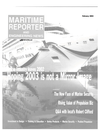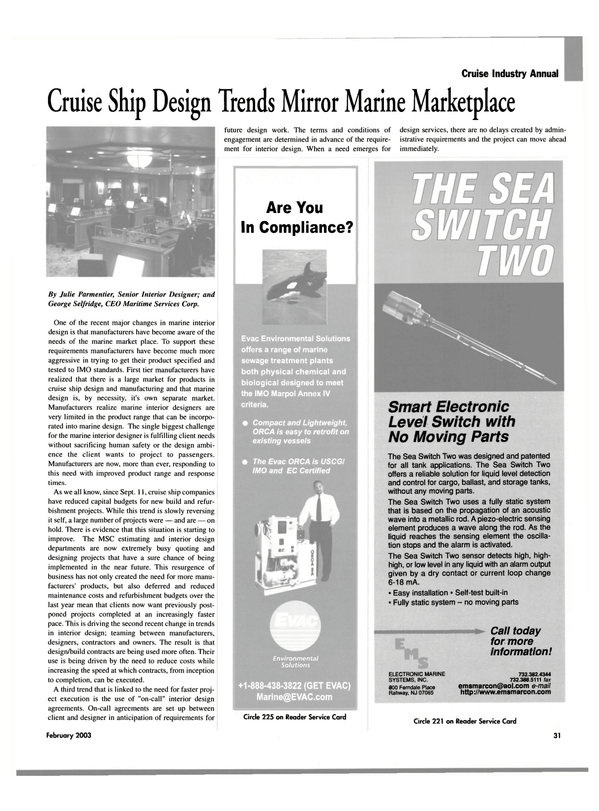
Cruise Ship Design Trends Mirror Marine Marketplace
One of the recent major changes in marine interior design is that manufacturers have become aware of the needs of the marine market place. To support these requirements manufacturers have become much more aggressive in trying to get their product specified and tested to IMO standards. First tier manufacturers have realized that there is a large market for products in cruise ship design and manufacturing and that marine design is, by necessity, it's own separate market.
Manufacturers realize marine interior designers are very limited in the product range that can be incorporated into marine design. The single biggest challenge for the marine interior designer is fulfilling client needs without sacrificing human safety or the design ambience the client wants to project to passengers.
Manufacturers are now, more than ever, responding to this need with improved product range and response times.
As we all know, since Sept. 11, cruise ship companies have reduced capital budgets for new build and refurbishment projects. While this trend is slowly reversing it self, a large number of projects were — and are — on hold. There is evidence that this situation is starting to improve. The MSC estimating and interior design departments are now extremely busy quoting and designing projects that have a sure chance of being implemented in the near future. This resurgence of business has not only created the need for more manufacturers' products, but also deferred and reduced maintenance costs and refurbishment budgets over the last year mean that clients now want previously postponed projects completed at an increasingly faster pace. This is driving the second recent change in trends in interior design; teaming between manufacturers, designers, contractors and owners. The result is that design/build contracts are being used more often. Their use is being driven by the need to reduce costs while increasing the speed at which contracts, from inception to completion, can be executed.
A third trend that is linked to the need for faster project execution is the use of "on-call" interior design agreements. On-call agreements are set up between client and designer in anticipation of requirements for future design work. The terms and conditions of engagement are determined in advance of the require- ment for interior design. When a need emerges for design services, there are no delays created by admin- istrative requirements and the project can move ahead immediately.
Better Safe Than Sorry Safety has always been a concern for Owners and operators. Whether driven by regulation, litigation or concern, a good portion of operational budgets have been and will continue to be allocated to safety functions. A thorough marine interior design must incorporate elements that incorporate and consider all of these concerns. ADA compliance is one of the most prominent concerns that consider regulation, litigation and concern for passenger comfort.
Operators have tended to resist some ADA requirements. Good marine interior planning must, however, be responsive to these requirements and design accordingly. This recently emerging trend need not be driven by the desire of the owner, (i.e.) be a stated goal of the design, but, rather, should be effortlessly incorporated into the design of each new or refurbished space. In this case good design must incorporate sometimes conflicted requirements into a seamless design within which ramps, hand rails, turning radiuses, toilet facili- ties and the like must be designed to both regulation and good design principals.
The "requirements" must disappear into, and become a part of a flawless design.
A smaller trend includes services related to recent technology and adding the creature comforts of home while maintaining the romance associated with cruising. Increased in-cabin services, the elimination of inside cabins in favor of outside cabins with balconies, cyber studies, rock walls, skating rinks and other high tech amenities continue to drive design in terms of form and function. Again the designer is faced with the question of incorporating advancing technology into a seamless interior design. How and where does a designer incorporate new e-mail stations into an existing public space layout and how can the design be blended into the surrounding spaces that will not be refurbished? Where does the flat screen television go? How will it be incorporated into the overall design? What affect will the addition have on existing wiring runs and access thereto, ventilation, traffic flow through the space, seating, wait staff considerations? What kind of services will be offered in passenger cabins?
Historically, owners and operators wanted the passengers enjoying the amenities of the public area spaces. Not only are the requirements for public spaces changing, the passenger cabin is becoming more of a focus.
It's About Demographics Demographic trends are also driving some changes. The traditional demographic lines dividing cruise ship pas- senger are changing, and dividing lines between generations are becoming smaller. Most passengers cruising today are looking for the feeling of youth, therefore they will seek out engaging activities and adventure. Frequent cruisers are seeking alternatives to the port stops with all the look-alike vendors in the Tiki shacks — many selling the same trinkets in Ketchikan and St.
Thomas. More often, the ship and the spaces within will become the focus — rather than the ports of call. Color and texture and the scientific and cultural use thereof can make a major impact on how people make use of and relate (favorably or otherwise) to the space they are in. As the ship becomes more of a focal point for the cruise holiday the requirement for spatial integration, wise use of color, variety and ease of movement become paramount requirements for the responsive interior designer.
Ceilings and bulkheads, from a regulatory standpoint, have not changed much over the recent past, but designers have new ways to take the most commonly used materials, such as lineal plank and standard 600 x 600 mm tiles.
To brighten bulkheads there are the standard foil type coverings that come with ships bulkhead system as well as highly decorative solid core systems.
Each has to be used where appropriate, sometimes in conjunction with each other.
Historically the color range in "soft core" systems has been limited, however, more wall vinyl companies are and have tested their vinyls to IMO standards.
Read Cruise Ship Design Trends Mirror Marine Marketplace in Pdf, Flash or Html5 edition of February 2003 Maritime Reporter
Other stories from February 2003 issue
Content
- The USCG, MTSA '02 and IMO - The New Faces of Security page: 8
- Littoral Combat Ship Takes One Step Closer to Reality page: 10
- Secure Marine Transportation... Priceless? page: 12
- Three PacifiCat-class Fast Ferries to be Sold page: 18
- The Rising Value of Propulsion Business page: 19
- Navigator of the Seas—A New Course for Profitability page: 24
- Plug and Play page: 28
- Cruise Ship Design Trends Mirror Marine Marketplace page: 31
- Deltamarin Expands to China to Thwart Cruise Downturn page: 34
- Gotar: Keeping Ships Clean From the Inside page: 35
- Coral Princess Debuts With Unique Propulsion System page: 35
- Sick Ships, Project America and a Merger page: 36
- A 360 O page: 38
- Swimmin' With the Fishes STN Atlas, WirtsilS Propulsion "Dolphin" Pod Proves Popular page: 38
- M/S Zuiderdam: Modern With Elegant Taste page: 40
- Construction on 10-Boat, $57-M Contract Commences for Brazil page: 44
- INCAT — A Delicate Balance for the Future page: 46
- NCL Debuts Newest Star with NYC Flair page: 48
- Damen Delivers High Level of Tug Tech page: 49
- A Proven, New Approach for Vessel Insulation page: 50
- The Dilemma: Competent Crews vs. Costs page: 54
- Blue Ridge Officers Complete Safety Training page: 57
- Shipping 2003: Don't Stop Thinking About Tomorrow page: 58
- Cruise Industry Gathers in Miami page: 61


